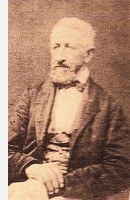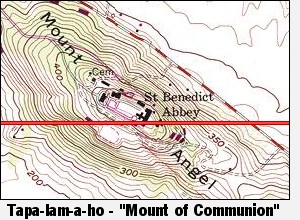Liberal University of Oregon
Timothy W. Davenport - 1826-1911
Extract from "Recollections of an Indian Agent" OHQ; Vol. 5, No. 1. March, 1904.
 Editor's Note: Timothy W. Davenport, father of Homer, was in his own right a remarkable person. He was a farmer, surveyor, Indian Agent, store owner, State legislator and more. In his later years, he took to writing. Over a period of several years, he contributed over a half dozen papers to the then-new Oregon Historical Society. The topics ranged from historical recollections to his own take on various aspects of society. In this extract from a longer later work on his experiences as a Federal Indian Agent, T.W. offers some insight into the original locals of the area, their spiritual beliefs, and their use of the surrounding country.
Editor's Note: Timothy W. Davenport, father of Homer, was in his own right a remarkable person. He was a farmer, surveyor, Indian Agent, store owner, State legislator and more. In his later years, he took to writing. Over a period of several years, he contributed over a half dozen papers to the then-new Oregon Historical Society. The topics ranged from historical recollections to his own take on various aspects of society. In this extract from a longer later work on his experiences as a Federal Indian Agent, T.W. offers some insight into the original locals of the area, their spiritual beliefs, and their use of the surrounding country.The differences observable in the various tribes and races of mankind are not, as many suppose, radical variations, that is, something of a different kind, but merely degrees of the same kind. The negro in his native state, hugging his fetish as a preventive of disease or other misfortune, the idolators bowing down to blocks of wood or stone to appease the wrath of their gods, as they read it in the earthquake, tornado, pestilence or famine, seem to strike us at first as indicative of another kind of creature, but upon more mature reflection we see in all such a different, though a ruder manifestation of the same human faculties, veneration and fear as modified by intelligence, or rather by ignorance.
Perhaps the educated Christian wearing his crucifix suspended by a golden necklace would protest against being linked with the savage, whose desire for immunity from disease or other calamity causes him to wear a charm; and as respects, the beautiful work of art worn by the former and the bag of stink worn by the latter, I would think the protest well taken, but the actuating and basic sentiment finding expression in one by enlightened and in the other by barbaric means is evidently the same quality of human nature. The Indians of the West Coast were given to amulets or charms, and generally kept them secreted. They believed, too, in a multiplicity of spirits distributed among the objects of nature, such as the spirits of the mountain, the stream, and smaller things. That is, the mountain had a, Ta-man-a-was; that was the name, given by many. They also believed in a Great Spirit, but whether that idea was obtained from the missionaries, I cannot tell.
When I arrived in Oregon in 1851, the Indians every where I met them talked about the Sohli Tyee, or God, though they still spoke of the spirit of things. In either case he is not so far removed from civilized man and his religious habits as some suppose, and if logical perception is not sufficient proof of this, the conversion of the savage to Christianity and the adoption by him of the Christian symbols with entire satisfaction of his inherited traits ought to be conclusive.
Through such manifestations it is not hard to discover that the Indian is a religious being and, given to worship. He and his white brother are alike in seeing God in the clouds and hearing him in the wind; the only difference is, the red man's "...soul was never taught to stray far as the solar walk or milky way." In some respects, however, I have been inclined to think him equally esthetic and more in practical conformity with Christian teaching than his more progressed white brother.
 In the eastern part of Marion County, Oregon, there stands an isolated and most strikingly regular and beautiful butte some three hundred feet in height and covering nearly a section of land. It was fringed about its base, at the time of which I write, with fir groves, but its sides and well-rounded and. spacious top were devoid of timber, except a few old and spreading oaks, and perhaps a half dozen gigantic firs, whose weighty limbs were drooping with age. A meridian section line passes over the middle of this butte, and four sections corner near its top. While running this line and establishing these corners in 1851, I observed many semicircular walls of stone, each enclosing space enough for a comfortable seat, and as high as one's shoulders when in a sitting posture, upon cross-sticks as high as the knee.
In the eastern part of Marion County, Oregon, there stands an isolated and most strikingly regular and beautiful butte some three hundred feet in height and covering nearly a section of land. It was fringed about its base, at the time of which I write, with fir groves, but its sides and well-rounded and. spacious top were devoid of timber, except a few old and spreading oaks, and perhaps a half dozen gigantic firs, whose weighty limbs were drooping with age. A meridian section line passes over the middle of this butte, and four sections corner near its top. While running this line and establishing these corners in 1851, I observed many semicircular walls of stone, each enclosing space enough for a comfortable seat, and as high as one's shoulders when in a sitting posture, upon cross-sticks as high as the knee.And what was the purpose of these stone chairs? I was determined to know, and the older white residents said the Indians made them, but for what purpose they could not say. I became a witness to the use, and was particularly impressed with the fitness for what I saw. Indians from the North and South traveling that way generally camped upon the banks of the Abiqua Creek, a rapid stream of pure, cold water, just issued from the mountains upon the plain. The butte was near, and this they ascended and, taking seats within the stone sanctuaries, communed in with the Great Spirit. Bowing the head upon the hands and resting them upon the knees for a few moments, then sitting erect and gazing to the West over the enchanting valley interspersed with meadow grove and stream, who can tell but they felt as sacred and elevated religious emotion as those who have succeeded them on the butte?
The Catholics have purchased it and erected upon its summit an awe-inspiring cathedral, and there upon Mount Angel, as they have named it, the prayers of the religious ascend. The Indians' name for this grand mount, dedicated by them to the service of their God, was Tapa-lam-a-ho, signifying in our language Mount of Communion; the plain to the West, Chek-ta, signifying beautiful or enchanting.
Now, looking at and comparing the two modes of worship, could any unprejudiced person fail to give the preference to the so-called savage-that is, if we are to regard Christ's precepts as worthy of note? He did not climb to the top of Tapa-lam-a-ho to show off his good clothes, to be heard of men, to proselyte, or to increase his worldly gear. What was his purpose? Evidently religious worship. What was the burden of his supplication? As to that we can only infer that, like other human beings, he prayed for what he wanted.
He was not, however, in want of food, for the Abiqua was swarming with trout; the valley was blue with the bloom of his edible root, the sweet camas; from every grove came the love notes of the grouse, and the mountains near at hand were populous with bigger game. He did not want clothing, for the fur that warmed the bear warmed him. In all that great valley of the Willamette he had not an enemy from whom he sought deliverance and being no politician and not aspiring to place, I have been at my wits' end in trying to fix upon a rational subject of his prayer, except it be that unrest of spirit which seeks escape from the bonds of clay and longs to rest in sublimer spheres, a characteristic of all the tribes of men. If not so, why should he ascend to the mountain top to pray? Why not pray on low ground?
I put this latter question to the unostentatious worshippers; and although they were untaught in history, had never heard of Moses' interviews with Jehovah upon Mount Sinai, or of the earthly rendezvous of the Grecian Gods and Goddesses upon Mount Olympus, their answer proved that they are at one with the whole human race, viz: "Soh-li Tyee mit-lite wake siah copa, sohli illahee," which, translated into our language, means that God is near to the mountain top, or God is near by in the mountains.
Image by Courtesy the Geer Family Archives

